Changes in Coastal Agricultural Land Use in Response to Climate Change: An Assessment Using Satellite Remote Sensing and Household Survey Data in Tien Hai District, Thai Binh Province, Vietnam
Abstract
1. Introduction
2. Materials and Methods
2.1. Study Area
2.2. Data Sources
2.3. Image Processing
3. Results and Discussion
3.1. Satellite Image Classification
3.2. Land-Use Changes Over Time
3.3. Impact of Climate Change on Agriculture Production
3.3.1. Impacts of Climate Change on Crop Production
3.3.2. Impacts of Climate Change on Aquaculture
3.4. Farmers’ Responses to Climate Change
4. Conclusions
Author Contributions
Funding
Institutional Review Board Statement
Informed Consent Statement
Data Availability Statement
Conflicts of Interest
Appendix A
| Reference Points 2005 | ||||||||
| Paddy | Annual Crop | Perennial Crop | Aquaculture | Forest | Other | Column Total | ||
| Classified image 2005 (LT51260462005195BJC00) | Paddy | 26 | 3 | 0 | 2 | 0 | 0 | 31 |
| Annual crop | 2 | 25 | 2 | 0 | 0 | 2 | 31 | |
| Perennial crop | 0 | 0 | 23 | 1 | 2 | 2 | 28 | |
| Aquaculture | 1 | 1 | 0 | 26 | 1 | 2 | 31 | |
| Forest | 0 | 0 | 3 | 0 | 25 | 0 | 28 | |
| Others | 1 | 1 | 2 | 1 | 2 | 24 | 31 | |
| Row total | 30 | 30 | 30 | 30 | 30 | 30 | 180 | |
| Producer’s Accuracy | 86.67 | 83.33 | 76.67 | 86.67 | 83.33 | 80.00 | ||
| User’s Accuracy | 83.87 | 80.65 | 82.14 | 83.87 | 89.29 | 77.42 | ||
| Overall Accuracy | 82.77 | |||||||
| Kappa Coefficient | 0.7901 | |||||||
| Reference Points 2010 | ||||||||
| Paddy | Annual Crop | Perennial Crop | Aquaculture | Forest | Other | Column Total | ||
| Classified image 2010 (LT51260462010193BKT00) | Paddy | 27 | 2 | 0 | 2 | 0 | 1 | 32 |
| Annual crop | 1 | 26 | 2 | 0 | 1 | 1 | 31 | |
| Perennial crop | 0 | 0 | 24 | 0 | 2 | 2 | 28 | |
| Aquaculture | 2 | 0 | 1 | 25 | 0 | 1 | 29 | |
| Forest | 0 | 0 | 2 | 2 | 27 | 2 | 33 | |
| Others | 0 | 2 | 1 | 1 | 0 | 23 | 27 | |
| Row total | 30 | 30 | 30 | 30 | 30 | 30 | 180 | |
| Producer’s Accuracy | 90.00 | 86.67 | 80.00 | 83.33 | 90.00 | 76.67 | ||
| User’s Accuracy | 84.38 | 83.87 | 85.71 | 86.21 | 81.82 | 85.19 | ||
| Overall Accuracy | 84.44 | |||||||
| Kappa Coefficient | 0.8023 | |||||||
| Reference Points 2015 | ||||||||
| Paddy | Annual Crop | Perennial Crop | Aquaculture | Forest | Other | Column Total | ||
| Classified image 2015 (LC81260462015191LGN01) | Paddy | 28 | 2 | 0 | 1 | 0 | 0 | 31 |
| Annual crop | 0 | 25 | 2 | 0 | 0 | 0 | 27 | |
| Perennial crop | 0 | 2 | 25 | 0 | 0 | 1 | 28 | |
| Aquaculture | 2 | 0 | 0 | 26 | 2 | 2 | 32 | |
| Forest | 0 | 0 | 3 | 1 | 28 | 2 | 34 | |
| Others | 0 | 1 | 0 | 2 | 0 | 25 | 28 | |
| Row total | 30 | 30 | 30 | 30 | 30 | 30 | 180 | |
| Producer’s Accuracy | 93.33 | 83.33 | 83.33 | 86.67 | 93.33 | 83.33 | ||
| User’s Accuracy | 90.32 | 92.59 | 89.29 | 81.25 | 82.35 | 89.29 | ||
| Overall Accuracy | 87.22 | |||||||
| Kappa Coefficient | 0.8217 | |||||||
| Reference Points 2020 | ||||||||
| Paddy | Annual Crop | Perennial Crop | Aquaculture | Forest | Other | Column Total | ||
| Classified image 2020 (LC812604620200705L1TP) | Paddy | 28 | 3 | 0 | 2 | 0 | 1 | 34 |
| Annual crop | 1 | 25 | 2 | 0 | 0 | 0 | 28 | |
| Perennial crop | 0 | 0 | 24 | 0 | 2 | 2 | 28 | |
| Aquaculture | 1 | 1 | 1 | 27 | 1 | 1 | 32 | |
| Forest | 0 | 0 | 1 | 0 | 27 | 1 | 29 | |
| Others | 0 | 1 | 2 | 1 | 0 | 25 | 29 | |
| Row total | 30 | 30 | 30 | 30 | 30 | 30 | 180 | |
| Producer’s Accuracy | 93.33 | 83.33 | 80.00 | 90.00 | 90.00 | 83.33 | ||
| User’s Accuracy | 82.35 | 89.29 | 85.71 | 84.38 | 93.10 | 86.21 | ||
| Overall Accuracy | 86.67 | |||||||
| Kappa Coefficient | 0.8115 | |||||||
References
- Bennett, L. Deforestation and Climate Change; Climate Institute: Washington, DC, USA, 2017; Volume 1400. [Google Scholar]
- Lawrence, D.; Vandecar, K. Effects of tropical deforestation on climate and agriculture. Nat. Clim. Chang. 2015, 5, 27–36. [Google Scholar] [CrossRef]
- Shukla, P.; Skea, J.; Calvo Buendia, E.; Masson-Delmotte, V.; Pörtner, H.; Roberts, D.; Zhai, P.; Slade, R.; Connors, S.; Van Diemen, R. Climate Change and Land: An IPCC Special Report on Climate change, Desertification, Land Degradation, Sustainable Land Management, Food Security, and Greenhouse Gas Fluxes in Terrestrial Ecosystems; IPCC: Geneva, Switzerland, 2019; p. 864. [Google Scholar]
- Crumpler, K.; Dasgupta, S.; Federici, S.; Meybeck, A.; Bloise, M.; Slivinska, V.; Salvatore, M.; Damen, B.; Loeben, S.V.; Wolf, J.; et al. Regional analysis of the nationally determined contributions in Asia–Gaps and opportunities in the agriculture and land use sectors. In Environment and Natural Resources Management Working Paper No. 78; FAO: Rome, Italy, 2020. [Google Scholar]
- Zhang, X.; Cai, X. Climate change impacts on global agricultural land availability. Environ. Res. Lett. 2011, 6, 014014. [Google Scholar] [CrossRef]
- ADB. Vietnam: Environment and Climate Change Assessment. Available online: https://www.adb.org/documents/viet-nam-environment-and-climate-change-assessment (accessed on 24 May 2021).
- Christoplos, I.; Ngoan, L.D.; Sen, L.T.H.; Huong, N.T.T.; Nguyen, H. Changing arenas for agricultural climate change adaptation in Vietnam. Dev. Pract. 2017, 27, 132–142. [Google Scholar] [CrossRef]
- Nguyen, T.A.; Vu, D.A.; Van Vu, P.; Nguyen, T.N.; Pham, T.M.; Nguyen, H.T.T.; Le, H.T.; Nguyen, T.V.; Hoang, L.K.; Vu, T.D. Human ecological effects of tropical storms in the coastal area of Ky Anh (Ha Tinh, Vietnam). Environ. Dev. Sustain. 2017, 19, 745–767. [Google Scholar] [CrossRef]
- WorldBank. Economics of Adaptation to Climate Change: Vietnam. Available online: https://openknowledge.worldbank.org/handle/10986/12747 (accessed on 5 February 2021).
- Chakraborty, S.; Tiedemann, A.; Teng, P.S. Climate change: Potential impact on plant diseases. Environ. Pollut. 2000, 108, 317–326. [Google Scholar] [CrossRef]
- Zhu, T.; Trinh, M. Climate change impacts on agriculture in Vietnam. In Proceedings of the International Conference on Agricultural Risk and Food Security, Beijing, China, 11–12 June 2010; pp. 11–12. [Google Scholar]
- Knox, J.; Hess, T.; Daccache, A.; Wheeler, T. Climate change impacts on crop productivity in Africa and South Asia. Environ. Res. Lett. 2012, 7, 034032. [Google Scholar] [CrossRef]
- Coakley, S.M.; Scherm, H.; Chakraborty, S. Climate change and plant disease management. Annu. Rev. Phytopathol. 1999, 37, 399–426. [Google Scholar] [CrossRef]
- Thanh, D.V.; Viet, N.V. Tác động của biến đổi khí hậu đến ngành nông nghiệp và giải pháp ứng phó [Impacts of Climate Change on Agriculture Sector and Response Measures]; Agricultural Publishing House: Hanoi, Vietnam, 2014. [Google Scholar]
- Maulu, S.; Hasimuna, O.J.; Haambiya, L.H.; Monde, C.; Musuka, C.G.; Makorwa, T.H.; Munganga, B.P.; Phiri, K.J.; Nsekanabo, J.D. Climate Change Effects on Aquaculture Production: Sustainability Implications, Mitigation, and Adaptations. Front. Sustain. Food Syst. 2021, 5, 70. [Google Scholar] [CrossRef]
- Mohanty, B.; Mohanty, S.; Sahoo, J.; Sharma, A. Climate change: Impacts on fisheries and aquaculture. In Climate Change and Variability; IntechOpen: Winchester, UK, 2010; pp. 119–138. [Google Scholar]
- Seggel, A.; De Young, C. Climate Change Implications for Fisheries and Aquaculture: Summary of the Findings of the Intergovernmental Panel on Climate Change Fifth Assessment Report. In FAO Fisheries and Aquaculture Circular No. C1122; FAO: Rome, Italy, 2016; p. 54. [Google Scholar]
- Pete, S.; Mark, H.; Thelma, K.; Valérie, M.-D.; Cheikh, M.; Hans-Otto, P.; Andy, R.; Josep, C.; Phillip, O.B. Special Report on Climate change, Desertification, Land Degradation, Sustainable Land Management, Food Security, and Greenhouse Gas Fluxes in Terrestrial Ecosystems (SR2); IPCC: Cambridge, UK, 2017; p. 32. [Google Scholar]
- Allison, E.H.; Perry, A.L.; Badjeck, M.C.; Neil Adger, W.; Brown, K.; Conway, D.; Halls, A.S.; Pilling, G.M.; Reynolds, J.D.; Andrew, N.L. Vulnerability of national economies to the impacts of climate change on fisheries. Fish Fish. 2009, 10, 173–196. [Google Scholar] [CrossRef]
- Boateng, I. GIS assessment of coastal vulnerability to climate change and coastal adaption planning in Vietnam. J. Coast. Conserv. 2012, 16, 25–36. [Google Scholar] [CrossRef]
- Nicholls, R.J.; Wong, P.P.; Burkett, V.; Codignotto, J.; Hay, J.; McLean, R.; Ragoonaden, S.; Woodroffe, C.D.; Abuodha, P.; Arblaster, J. Coastal Systems and Low-Lying Areas. Climate Change 2007: Impacts, Adaptation and Vulnerability. Contribution of Working Group II to the Fourth Assessment Report of the Intergovernmental Panel on Climate Change; Cambridge University Press: Cambridge, UK, 2007; pp. 315–356. [Google Scholar]
- Tobey, J.; Rubinoff, P.; Robadue, D.; Ricci, G.; Anderson, G.; Furlow, J.; Volk, R.; Squillante, L. Adapting to Coastal Climate Change: A Guidebook for Development Planners; Coastal Resources Center, University of Rhode Island: Narragansett, RI, USA, 2009; p. 164. [Google Scholar]
- Agrawal, A. Local institutions and adaptation to climate change. Soc. Dimens. Clim. Chang. Equity Vulnerability A Warm. World 2010, 2, 173–178. [Google Scholar]
- Baills, A.; Garcin, M.; Bulteau, T. Assessment of selected climate change adaptation measures for coastal areas. Ocean Coast. Manag. 2020, 185, 105059. [Google Scholar] [CrossRef]
- Sinay, L.; Carter, R. Climate change adaptation options for coastal communities and local governments. Climate 2020, 8, 7. [Google Scholar] [CrossRef]
- Chen, S.; De Bruyne, C.; Bollempalli, M. Blue Economy: Community Case Studies Addressing the Poverty–Environment Nexus in Ocean and Coastal Management. Sustainability 2020, 12, 4654. [Google Scholar] [CrossRef]
- CoastAdapt. Adaptation Options for Managing Coastal Risks under Climate Change. Available online: https://coastadapt.com.au/adaptation-options (accessed on 24 May 2021).
- Bangalore, M.; Smith, A.; Veldkamp, T. Exposure to floods, climate change, and poverty in Vietnam. Nat. Hazards Earth Syst. Sci. Discuss. 2017, 1–28. [Google Scholar] [CrossRef]
- Michalak, W. GIS in land use change analysis: Integration of remotely sensed data into GIS. Appl. Geogr. 1993, 13, 28–44. [Google Scholar] [CrossRef]
- Fox, J.; Krummel, J.; Yarnasarn, S.; Ekasingh, M.; Podger, N. Land-use and landscape dynamics in northern Thailand: Assessing change in three upland watersheds since 1954. Ambio 1995, 24, 328–334. [Google Scholar]
- Rindfuss, R.R.; Walsh, S.J.; Turner, B.; Moran, E.F.; Entwisle, B. Linking pixels and people. In Land Change Science; Springer: Berlin/Heidelberg, Germany, 2012; pp. 379–394. [Google Scholar]
- Turner, B.; Meyer, W.B. Land use and land cover in global environmental change: Considerations for study. Int. Soc. Sci. J. 1991, 43, 669–679. [Google Scholar]
- Walsh, S.J.; Evans, T.P.; Welsh, W.F.; Entwisle, B.; Rindfuss, R.R. Scale-dependent relationships between population and environment in northeastern Thailand. Photogramm. Eng. Remote Sens. 1999, 65, 97. [Google Scholar]
- Turner, B.L.; Lambin, E.F.; Reenberg, A. The emergence of land change science for global environmental change and sustainability. Proc. Natl. Acad. Sci. USA 2007, 104, 20666–20671. [Google Scholar] [CrossRef]
- Pedersen, A.; Thang, N.H. The Conservation of Key Coastal Wetland Sites in the Red River Delta; Hanoi BirdLife International Vietnam Programme: Hanoi, Vietnam, 1996; p. 97. [Google Scholar]
- Lillesand, T.; Kiefer, R.W.; Chipman, J. Remote Sensing and Image Interpretation; John Wiley & Sons: Hoboken, NJ, USA, 2015. [Google Scholar]
- Jensen, J.R. Introductory Digital Image Processing: A Remote Sensing Perspective; Prentice-Hall Inc.: Upper Saddle River, NJ, USA, 1996. [Google Scholar]
- Thang, D.D.; Thai, T.H.; Hoa, V.V. Đánh giá thực trạng và dự tính khả năng xâm nhập mặn cho khu vực ven biển tỉnh Thái Bình [Assessing the current situation and predicting the possibility of saline intrusion for the coastal area of Thai Binh province]. Vietnam J. Hydrometeorol. 2019, 9–16. [Google Scholar] [CrossRef]
- Nguyen, Y.T.B.; Kamoshita, A.; Matsuda, H.; Kurokura, H. Salinity intrusion and rice production in Red River Delta under changing climate conditions. Paddy Water Environ. 2017, 15, 37–48. [Google Scholar] [CrossRef]
- Quan, L.T.A.; Vo, T.C.; Nguyen, N.T.H. Đánh giá khả năng chịu mặn và phẩm chất của giống Lúa Sỏi, Một Bụi Hồng và Nàng Quớt Biển [Evaluation on saline tolerance ability and quality of Lua Soi, Mot Bui Hong, Nang Quot Bien varieties]. Can Tho Univ. J. Sci. 2012, 24a, 281–289. [Google Scholar]
- DONRE. Project Investigation and asSessment the Exploring and Using Statement of the Ground Water Resource in Thai Binh Up to 2011; Thai Binh Department of Natural Resources and Environment: Thai Binh, Vietnam, 2011. [Google Scholar]
- Trung, L.D. Economic and welfare impacts of disasters in East Asia and policy responses: The case of Vietnamese communities. In Resilience Recovery in Asian Disasters: Community Ties, Market Mechanisms, Governance; Economic Research Institute for ASEAN and East Asia: Jakarta, Indonesia, 2015; pp. 51–73. [Google Scholar]
- Cochrane, K.; De Young, C.; Soto, D.; Bahri, T. Climate change implications for fisheries and aquaculture. FAO Fish. Aquac. Tech. Pap. 2009, 530, 212. [Google Scholar]
- De Silva, S.S.; Soto, D. Climate change and aquaculture: Potential impacts, adaptation and mitigation. FAO Fish. Aquac. Tech. Pap. 2009, 530, 151–212. [Google Scholar]
- Islam, M.A.; Uddin, M.H.; Uddin, M.J.; Shahjahan, M. Temperature changes influenced the growth performance and physiological functions of Thai pangas Pangasianodon hypophthalmus. Aquac. Rep. 2019, 13, 100179. [Google Scholar] [CrossRef]
- Boyd, C.E. Effects of Weather and Climate on Aquaculture. Available online: https://www.aquaculturealliance.org/advocate/effects-of-weather-and-climate-on-aquaculture/ (accessed on 2 April 2021).
- Sallenave, R. Understanding Water Quality Parameters to Better Manage Your Pond; New Mexico State University, Cooperative Extension Service: Las Cruces, NM, USA, 2012. [Google Scholar]
- Kontara, E.K. Shrimp Culture Management Techniques. In Report of the Training Course on Shrimp Culture; FAO: Manila, Philippines, 1988; pp. 32–38. [Google Scholar]
- Pilarczyk, K.W.; Nuoi, N.S. Experience and practices on flood control in Vietnam. Water Int. 2005, 30, 114–122. [Google Scholar] [CrossRef]
- Jacobs, C.; Berglund, M.; Kurnik, B.; Dworak, T.; Marras, S.; Mereu, V.; Michetti, M. Climate Change Adaptation in the Agriculture Sector in Europe; European Environment Agency (EEA): Copenhagen, Denmark, 2019. [Google Scholar]
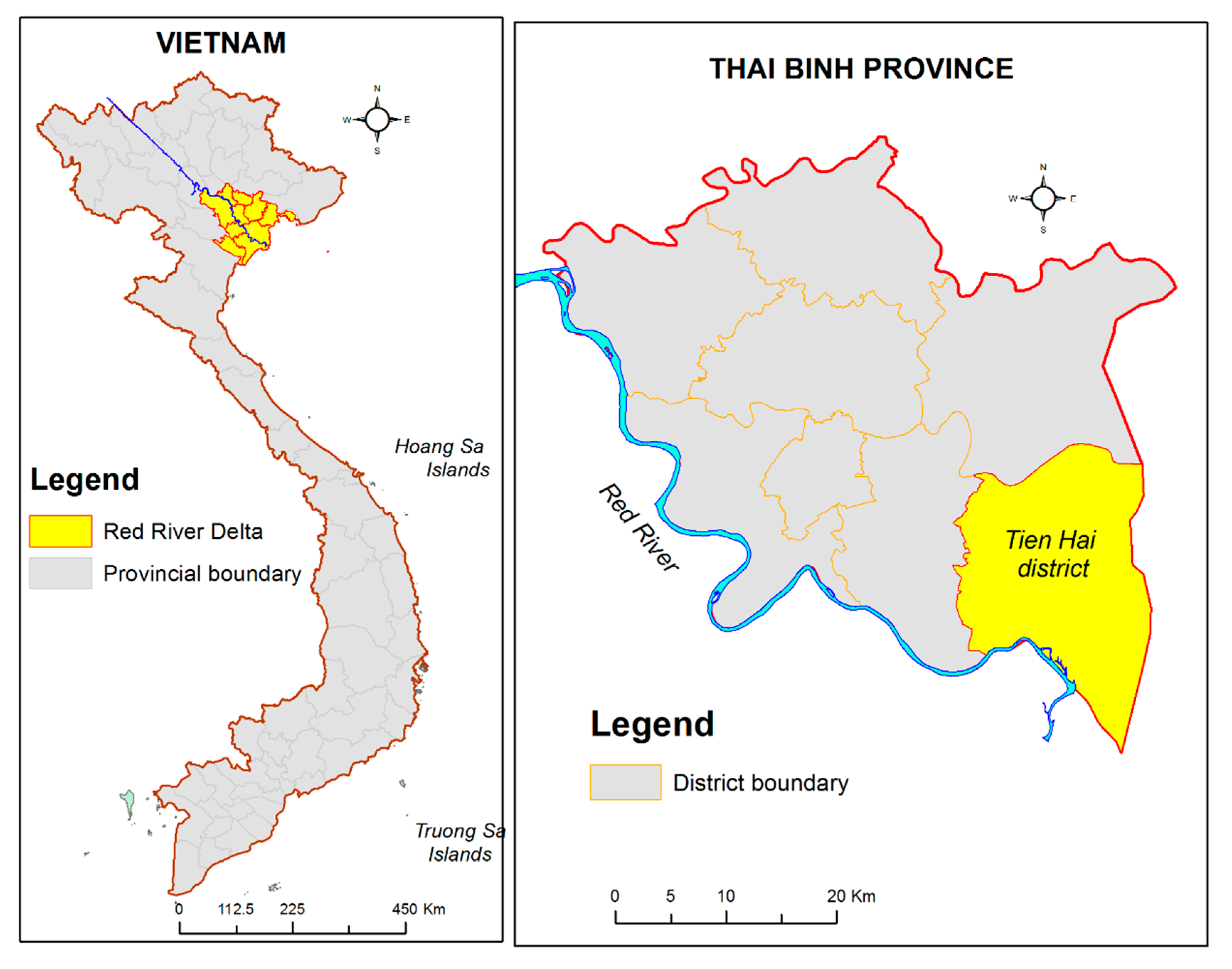
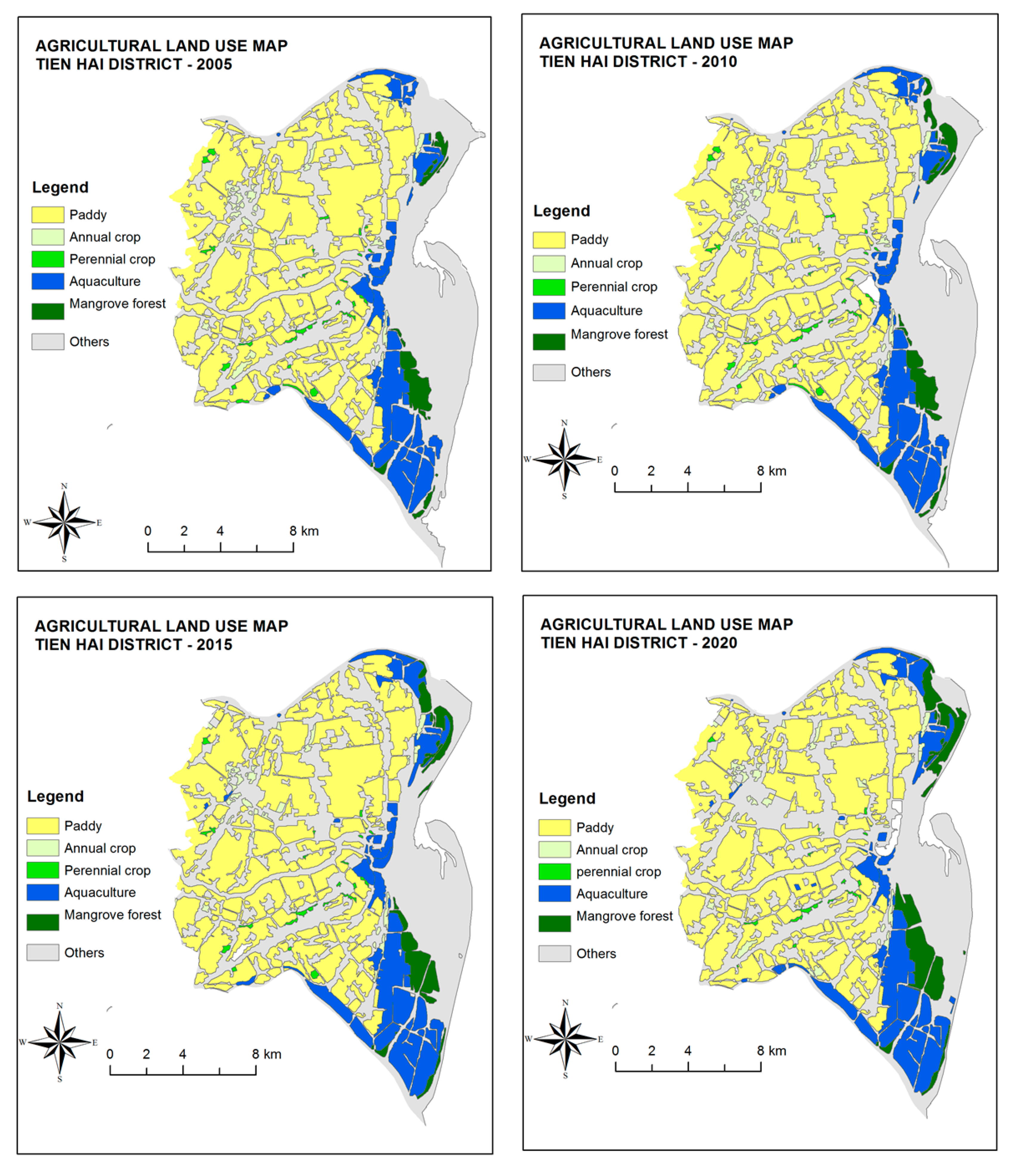

| Year | ID | Acquisition Date | Resolution | Parameters |
|---|---|---|---|---|
| 2005 | LT51260462005195BJC00 | 14 July 2005 | 30 m | Types: Level 1—Corrected Output Format: Geo TIFF Resampling Method: CC Map Projection: UTM-WGS 84 |
| 2010 | LT51260462010193BKT00 | 12 July 2010 | 30 m | |
| 2015 | LC81260462015191LGN01 | 10 July 2015 | 30 m, 15 m | |
| 2020 | LC812604620200705L1TP | 5 July 2020 | 30 m, 15 m |
| No | Land-Use Types | Satellite Image | Ground Photo |
|---|---|---|---|
| 1 | Paddy |  | 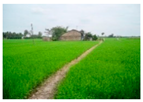 |
| 2 | Annual crop | 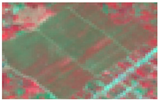 | 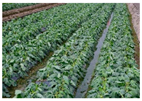 |
| 3 | Perennial crop |  |  |
| 4 | Forests |  |  |
| 5 | Aquaculture | 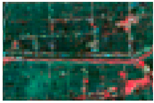 |  |
| 6 | Others |  |  |
| Classified Images | Total Number of Pixels | Number of Correct Pixels | Overall Accuracy (%) | Kappa Coefficient |
|---|---|---|---|---|
| LT51260462005195BJC00 | 180 | 149 | 82.77 | 0.7901 |
| LT51260462010193BKT00 | 180 | 152 | 84.44 | 0.8023 |
| LC81260462015191LGN01 | 180 | 157 | 87.22 | 0.8217 |
| LC812604620200705L1TP | 180 | 156 | 86.66 | 0.8115 |
| Year | 2005 | 2010 | 2015 | 2020 | |||||
|---|---|---|---|---|---|---|---|---|---|
| Land Uses | Ha | % | Ha | % | Ha | % | Ha | % | |
| Paddy | 11,531.00 | 42.06 | 11,491.93 | 41.92 | 11,357.20 | 41.42 | 11,045.42 | 40.29 | |
| Annual Crop | 461.78 | 1.68 | 453.63 | 1.65 | 439.11 | 1.60 | 464.93 | 1.70 | |
| Perennial Crop | 200.20 | 0.73 | 185.37 | 0.68 | 154.28 | 0.56 | 90.50 | 0.33 | |
| Aquaculture | 2549.03 | 9.30 | 2796.56 | 10.20 | 3079.46 | 11.23 | 3115.91 | 11.37 | |
| Forest | 547.75 | 2.00 | 736.80 | 2.69 | 930.35 | 3.39 | 1320.35 | 4.82 | |
| Others | 12,126.68 | 44.23 | 11,752.15 | 42.87 | 11,456.04 | 41.79 | 11,379.33 | 41.51 | |
| Total | 27,416.44 | 100.00 | 27,416.44 | 100.00 | 27,416.44 | 100.00 | 27,416.44 | 100.00 | |
| Land Use 2010 | Total | |||||||
|---|---|---|---|---|---|---|---|---|
| Paddy | Annual Crop | Perennial Crop | Aquaculture | Forest | Others | |||
| Land use 2005 | Paddy | 11,451.32 | 17.55 | 62.13 | 11,531.00 | |||
| Annual crop | 2.18 | 424.53 | 35.07 | 461.78 | ||||
| Perennial crop | 10.98 | 185.37 | 3.85 | 200.20 | ||||
| Aquaculture | 2549.03 | 2549.03 | ||||||
| Forest | 540.57 | 7.18 | 547.75 | |||||
| Others | 38.43 | 0.57 | 247.53 | 196.23 | 11,643.92 | 12,126.68 | ||
| Total | 11,491.93 | 453.63 | 185.37 | 2796.56 | 736.80 | 11,752.15 | 27,416.44 | |
| Land Use 2015 | Total | |||||||
|---|---|---|---|---|---|---|---|---|
| Paddy | Annual Crop | Perennial Crop | Aquaculture | Forest | Other | |||
| Land use 2010 | Paddy | 11,254.76 | 42.22 | 82.63 | 112.32 | 11,491.93 | ||
| Annual crop | 16.12 | 390.07 | 30.77 | 16.67 | 453.63 | |||
| Perennial crop | 11.21 | 152.55 | 13.22 | 8.39 | 185.37 | |||
| Aquaculture | 35.41 | 6.82 | 2712.11 | 8.32 | 33.90 | 2796.56 | ||
| Forest | 2.33 | 718.90 | 15.57 | 736.80 | ||||
| Others | 39.70 | 1.73 | 238.40 | 203.13 | 11,269.19 | 11,752.15 | ||
| Total | 11,357.2 | 439.11 | 154.28 | 3079.46 | 930.35 | 11,456.04 | 27,416.44 | |
| Land Use 2020 | Total | |||||||
|---|---|---|---|---|---|---|---|---|
| Paddy | Annual Crop | Perennial Crop | Aquaculture | Forest | Other | |||
| Land use 2015 | Paddy | 10,998.18 | 70.45 | 48.97 | 239.60 | 11,357.20 | ||
| Annual crop | 0.18 | 369.36 | 2.85 | 66.72 | 439.11 | |||
| Perennial crop | 7.34 | 15.18 | 90.50 | 5.14 | 36.12 | 154.28 | ||
| Aquaculture | 13.17 | 2.95 | 3006.60 | 16.14 | 40.60 | 3079.46 | ||
| Forest | 930.35 | 930.35 | ||||||
| Others | 26.55 | 6.99 | 52.35 | 373.86 | 10,996.29 | 11,456.04 | ||
| Total | 11,045.42 | 464.93 | 90.50 | 3115.91 | 1320.35 | 11,379.33 | 27,416.44 | |
| Impact of Extreme Cold | Frequency N = 75 | Percentage * |
| Die-off | 52 | 69.33 |
| Poor crop growth | 48 | 64.00 |
| Reduce productivity | 28 | 37.33 |
| Impact of Saltwater Intrusion | Frequency N = 75 | Percentage |
| Abandoned fields | 56 | 74.67 |
| Reduce productivity | 48 | 64.00 |
| Poor crop growth | 22 | 29.33 |
| Die-off | 25 | 33.33 |
| Impact of Extremely High Temperature | Frequency N = 75 | Percentage |
| Water shortage | 47 | 62.67 |
| Increase diseases | 34 | 45.33 |
| Reduce productivity | 30 | 40.00 |
| Die-off | 30 | 40.00 |
| Impact of Storm | Frequency N = 75 | Percentage |
| Property damaged | 65 | 86.67 |
| Reduce productivity | 52 | 69.33 |
| Soil erosion | 25 | 33.33 |
| Impact of Extreme Cold Events | Frequency N = 75 | Percentage ** |
| Lower harvest | 53 | 70.67 |
| Mass die-off | 39 | 52.00 |
| Total production losses | 27 | 36.00 |
| Impact of Extreme Hot Event | Frequency N = 75 | Percentage |
| Affects the water environment | 64 | 85.33 |
| Mass die-off | 49 | 65.33 |
| Susceptible to diseases | 46 | 61.33 |
| Impact of Storm | Frequency N = 75 | Percentage |
| Destroys farm facilities | 67 | 89.33 |
| Affects the water environment | 53 | 70.67 |
| Increases risk from water-borne pathogens | 47 | 62.67 |
| Total production losses | 28 | 37.33 |
| Crop Production | Frequency N = 75 | Percentage *** |
| Changing crop varieties | 58 | 77.33 |
| Adjusting crop timing | 56 | 74.67 |
| Adjusting cropping pattern | 25 | 33.33 |
| Converting cropland to aquaculture | 22 | 29.33 |
| Shifting occupation | 16 | 21.33 |
| Aquaculture Production | Frequency N = 75 | Percentage |
| Changing aquatic species | 60 | 80.00 |
| Adjusting cultivation techniques | 54 | 72.00 |
| Renovating aquaculture farms | 32 | 42.50 |
| Applying aquaculture crop rotation | 24 | 32.40 |
Publisher’s Note: MDPI stays neutral with regard to jurisdictional claims in published maps and institutional affiliations. |
© 2021 by the authors. Licensee MDPI, Basel, Switzerland. This article is an open access article distributed under the terms and conditions of the Creative Commons Attribution (CC BY) license (https://creativecommons.org/licenses/by/4.0/).
Share and Cite
Nong, D.H.; Ngo, A.T.; Nguyen, H.P.T.; Nguyen, T.T.; Nguyen, L.T.; Saksena, S. Changes in Coastal Agricultural Land Use in Response to Climate Change: An Assessment Using Satellite Remote Sensing and Household Survey Data in Tien Hai District, Thai Binh Province, Vietnam. Land 2021, 10, 627. https://doi.org/10.3390/land10060627
Nong DH, Ngo AT, Nguyen HPT, Nguyen TT, Nguyen LT, Saksena S. Changes in Coastal Agricultural Land Use in Response to Climate Change: An Assessment Using Satellite Remote Sensing and Household Survey Data in Tien Hai District, Thai Binh Province, Vietnam. Land. 2021; 10(6):627. https://doi.org/10.3390/land10060627
Chicago/Turabian StyleNong, Duong H., An T. Ngo, Hoa P. T. Nguyen, Thuy T. Nguyen, Lan T. Nguyen, and Summet Saksena. 2021. "Changes in Coastal Agricultural Land Use in Response to Climate Change: An Assessment Using Satellite Remote Sensing and Household Survey Data in Tien Hai District, Thai Binh Province, Vietnam" Land 10, no. 6: 627. https://doi.org/10.3390/land10060627
APA StyleNong, D. H., Ngo, A. T., Nguyen, H. P. T., Nguyen, T. T., Nguyen, L. T., & Saksena, S. (2021). Changes in Coastal Agricultural Land Use in Response to Climate Change: An Assessment Using Satellite Remote Sensing and Household Survey Data in Tien Hai District, Thai Binh Province, Vietnam. Land, 10(6), 627. https://doi.org/10.3390/land10060627






